|
|
The Holy Martyrs Terence, Africanus, Maximus, Pompeius and 36 others with
them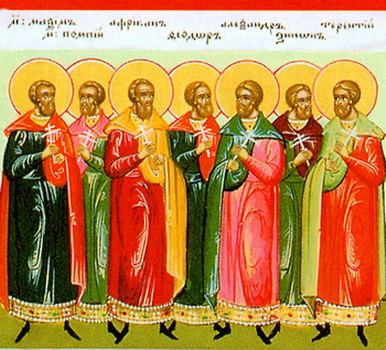 They suffered for Christ and were crowned with wreaths of glory in the time of the Emperor Decius. By the Emperor's orders, the governor of Africa notified all the people that they must offer sacrifice to idols. In the case of opposition, the governor was to put the stubborn to harsh torture. Hearing this threat, many lapsed from the Faith and worshipped idols. But these forty martyrs remained steadfast, for which they were put to torture. St Terence encouraged his companions with these words: 'Let us, my brethren, keep ourselves from denying Christ our God; that He may not deny us before His heavenly Father and the holy angels.' The governor divided them into two groups; thirty-six of them, after flogging and having salt rubbed in their open wounds, he beheaded. But the first four he cast into prison with heavy chains round their necks and on their hands and feet. An angel of God appeared to them in the prison and touched their chains, which fell from them. Then the angel brought them a table abundantly heaped with food, and fed them. They were again taken out and tortured, and again shut up in the prison. Also, the governor ordered sorcerers to gather as many poisonous reptiles as possible, such as snakes and scorpions, and to shut them up with the martyrs. But the reptiles would not touch the men of God, but huddled together in one corner, where they remained for three days. When the prison was opened on the third day, the reptiles fell on the sorcerers and bit them. At last the governor passed sentence of death on these four martyrs. When they were taken to the scaffold, they joyfully sang psalms and hymns of thanksgiving to God, who had accounted them worthy of a martyr's death. They suffered with honour and attained to the Kingdom in the year 250. They suffered for Christ and were crowned with wreaths of glory in the time of the Emperor Decius. By the Emperor's orders, the governor of Africa notified all the people that they must offer sacrifice to idols. In the case of opposition, the governor was to put the stubborn to harsh torture. Hearing this threat, many lapsed from the Faith and worshipped idols. But these forty martyrs remained steadfast, for which they were put to torture. St Terence encouraged his companions with these words: 'Let us, my brethren, keep ourselves from denying Christ our God; that He may not deny us before His heavenly Father and the holy angels.' The governor divided them into two groups; thirty-six of them, after flogging and having salt rubbed in their open wounds, he beheaded. But the first four he cast into prison with heavy chains round their necks and on their hands and feet. An angel of God appeared to them in the prison and touched their chains, which fell from them. Then the angel brought them a table abundantly heaped with food, and fed them. They were again taken out and tortured, and again shut up in the prison. Also, the governor ordered sorcerers to gather as many poisonous reptiles as possible, such as snakes and scorpions, and to shut them up with the martyrs. But the reptiles would not touch the men of God, but huddled together in one corner, where they remained for three days. When the prison was opened on the third day, the reptiles fell on the sorcerers and bit them. At last the governor passed sentence of death on these four martyrs. When they were taken to the scaffold, they joyfully sang psalms and hymns of thanksgiving to God, who had accounted them worthy of a martyr's death. They suffered with honour and attained to the Kingdom in the year 250.The 6,000 Holy Martyrs in GeorgiaIn the wilderness of David-Garejeli in Georgia there were twelve monasteries, in which monks had lived the ascetic life for centuries. In 1615, Shah Abbas I invaded Georgia, laid it waste and slew innumerable Christians. One day, while out hunting at dawn on Easter Day itself, he saw the light of many candles shining in the hills. This was the monks of all twelve monasteries in procession all round the Church of the Resurrection, walking with candles in their hands. When the Shah discovered that it was monks, he asked in disbelief: 'Isn't the whole of Georgia put to the sword by now?', and ordered his generals to go and slaughter the monks at once. An angel of God appeared to Abbot Arsenius, and revealed their imminent death to him, and Arsenius informed the brethren. They then all received Communion in the Holy Mysteries and prepared for death. Then the attackers arrived, hacked the abbot to pieces when he came out ahead of the others, and then killed all the rest. They all suffered with honour and were crowned with unfading wreaths in 1615. Thus ended the history of these famous monasteries, which had been like a flame of spiritual enlightenment in Georgia for more than 1,000 years. There remain just two today: St David and St John the Baptist. The King of Georgia, Archil, gathered the remains of all the martyrs and buried them. Their relics are to this day full of myrrh for the healing of those in sickness.
Martyrs James, presbyter, and Azadanes and Abdicius, deacons, of Persia (ca. 380)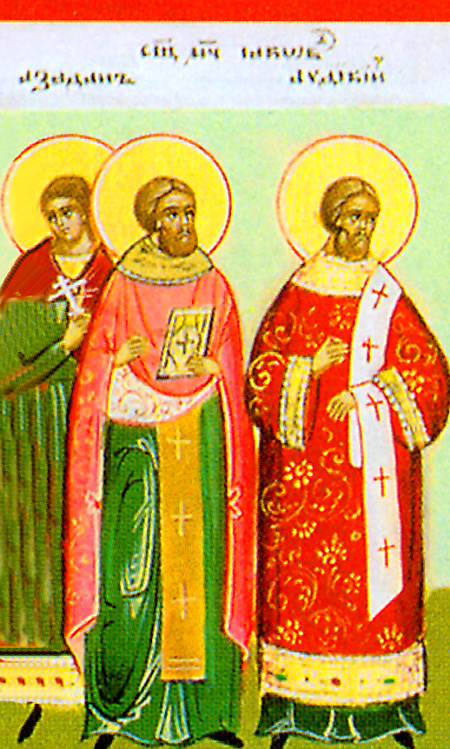 The Holy Martyrs James the Presbyter and the deacons Hazadanes and Habdikies died in Persia under the emperor Sapor in about the year 380. They were arrested together with Bishop Akepsim (Comm. 3 November). After long exhaustion from hunger in prison they inserted into the nostrils of the sufferers mustard with vinegar, and stripping them down led them out all night into the frost. In the morning, after new torments, they again locked them into prison and there beheaded them. The Holy Martyrs James the Presbyter and the deacons Hazadanes and Habdikies died in Persia under the emperor Sapor in about the year 380. They were arrested together with Bishop Akepsim (Comm. 3 November). After long exhaustion from hunger in prison they inserted into the nostrils of the sufferers mustard with vinegar, and stripping them down led them out all night into the frost. In the morning, after new torments, they again locked them into prison and there beheaded them.New Hieromartyr Gregory V, patriarch of Constantinople (1821)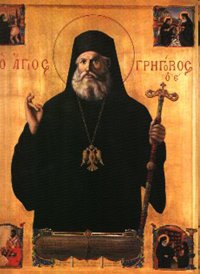 The PriestMartyr Gregory V, Patriarch of Constantinople, thrice occupied the cathedra-chair (1797-1799, 1806-1808, 1819-1821). During these times Greece found itself under the harsh Turkish yoke. many Greek patriots lived in the hope to again win national independence. They found active and authoritative support in a brave champion for freedom of their native land – in the holy Patriarch Gregory V. His connections with the Greek patriots came to light only when Alexander Ipsilanti with his army crossed over the River Prut against sultan Makhmul. One of the companions of the saint advised him to flee from Constantinople to Moreia. The saint answered him thus: "I sense, that the fishes of the Bosphorus will nibble at my body, but I shall die happy in the name of saving my nation".
On the day of Holy Pascha, 10 April 1821, they arrested the holy Patriarch and led him out of the doors of the Patriarchate, and then they threw his body into the sea.
Greek sailors noted the spot where the body of the saint was thrown, they found it, and on a ship of the Cephalonian captain Mark Sklabos under a Russian flag they sailed to Odessa. There, in the Greek church of the MostHoly Trinity, the body of the saint was buried on 19 June 1821. For dressing the remains of the priestmartyr, there was sent from Moscow vestments and a mitre with cross, which had belonged to His Holiness Patriarch Nikon (1652-1658).
In 1871 at the request of the Greek authorities it was decided to transfer the relics of Sainted Gregory from Odessa to Athens for the celebration of fifty years of Greek independence. In honour of the PriestMartyr Gregory, at Athens was compiled a special service. His deed contributed to the triumph of Christianity in the rebirth of Hellas. The PriestMartyr Gregory V, Patriarch of Constantinople, thrice occupied the cathedra-chair (1797-1799, 1806-1808, 1819-1821). During these times Greece found itself under the harsh Turkish yoke. many Greek patriots lived in the hope to again win national independence. They found active and authoritative support in a brave champion for freedom of their native land – in the holy Patriarch Gregory V. His connections with the Greek patriots came to light only when Alexander Ipsilanti with his army crossed over the River Prut against sultan Makhmul. One of the companions of the saint advised him to flee from Constantinople to Moreia. The saint answered him thus: "I sense, that the fishes of the Bosphorus will nibble at my body, but I shall die happy in the name of saving my nation".
On the day of Holy Pascha, 10 April 1821, they arrested the holy Patriarch and led him out of the doors of the Patriarchate, and then they threw his body into the sea.
Greek sailors noted the spot where the body of the saint was thrown, they found it, and on a ship of the Cephalonian captain Mark Sklabos under a Russian flag they sailed to Odessa. There, in the Greek church of the MostHoly Trinity, the body of the saint was buried on 19 June 1821. For dressing the remains of the priestmartyr, there was sent from Moscow vestments and a mitre with cross, which had belonged to His Holiness Patriarch Nikon (1652-1658).
In 1871 at the request of the Greek authorities it was decided to transfer the relics of Sainted Gregory from Odessa to Athens for the celebration of fifty years of Greek independence. In honour of the PriestMartyr Gregory, at Athens was compiled a special service. His deed contributed to the triumph of Christianity in the rebirth of Hellas.Prophetess Huldah (Olda)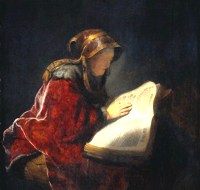 The Holy Prophetess Oldama (Huldah) lived in the first half of the VII Century before the Birth of Christ. She foretold to the 16 year old king of Judah reigning at Jerusalem, Josiah, that for his humility the Lord would put him with his forefathers and he would be at peace in the grave, and his eyes would not see all the woe, which the Lord would bring upon the land (4 (2) Kings 22: 14-20; 2 Chron. 34: 28). The Holy Prophetess Oldama (Huldah) lived in the first half of the VII Century before the Birth of Christ. She foretold to the 16 year old king of Judah reigning at Jerusalem, Josiah, that for his humility the Lord would put him with his forefathers and he would be at peace in the grave, and his eyes would not see all the woe, which the Lord would bring upon the land (4 (2) Kings 22: 14-20; 2 Chron. 34: 28). New Martyr Demos of Smyrna (1763)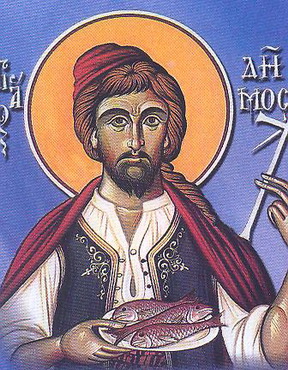 The Holy Martyr Dimos (Demos) was a fisherman. Because of very onerous conditions he refused to work for the Turkish owner employing him at Smyrna in the fish-business. The nasty Turk slandered Saint Dimos, saying that he had expressed a desire to accept Islam. Saint Dimos renounced this false charge and confessed himself a Christian. They locked him up in prison. While in heavy stocks for breaking his will they beat him with bricks and other sharp objects. After the execution of the martyr (+ 10 April 1763) Christians gathered up his holy remains and reverently buried them in the church of Saint George. The Holy Martyr Dimos (Demos) was a fisherman. Because of very onerous conditions he refused to work for the Turkish owner employing him at Smyrna in the fish-business. The nasty Turk slandered Saint Dimos, saying that he had expressed a desire to accept Islam. Saint Dimos renounced this false charge and confessed himself a Christian. They locked him up in prison. While in heavy stocks for breaking his will they beat him with bricks and other sharp objects. After the execution of the martyr (+ 10 April 1763) Christians gathered up his holy remains and reverently buried them in the church of Saint George. |